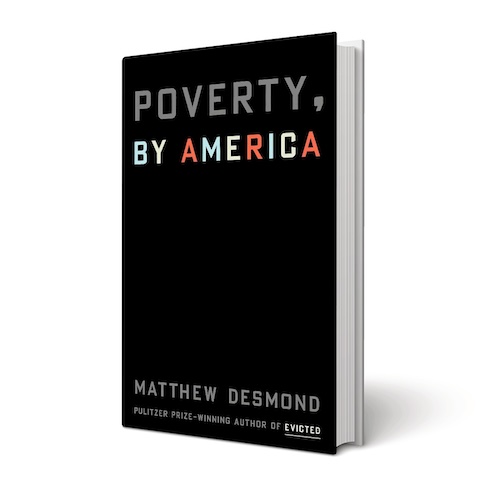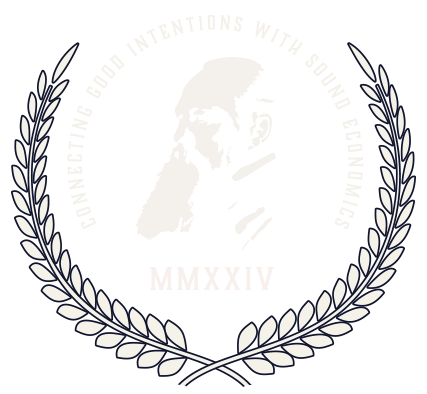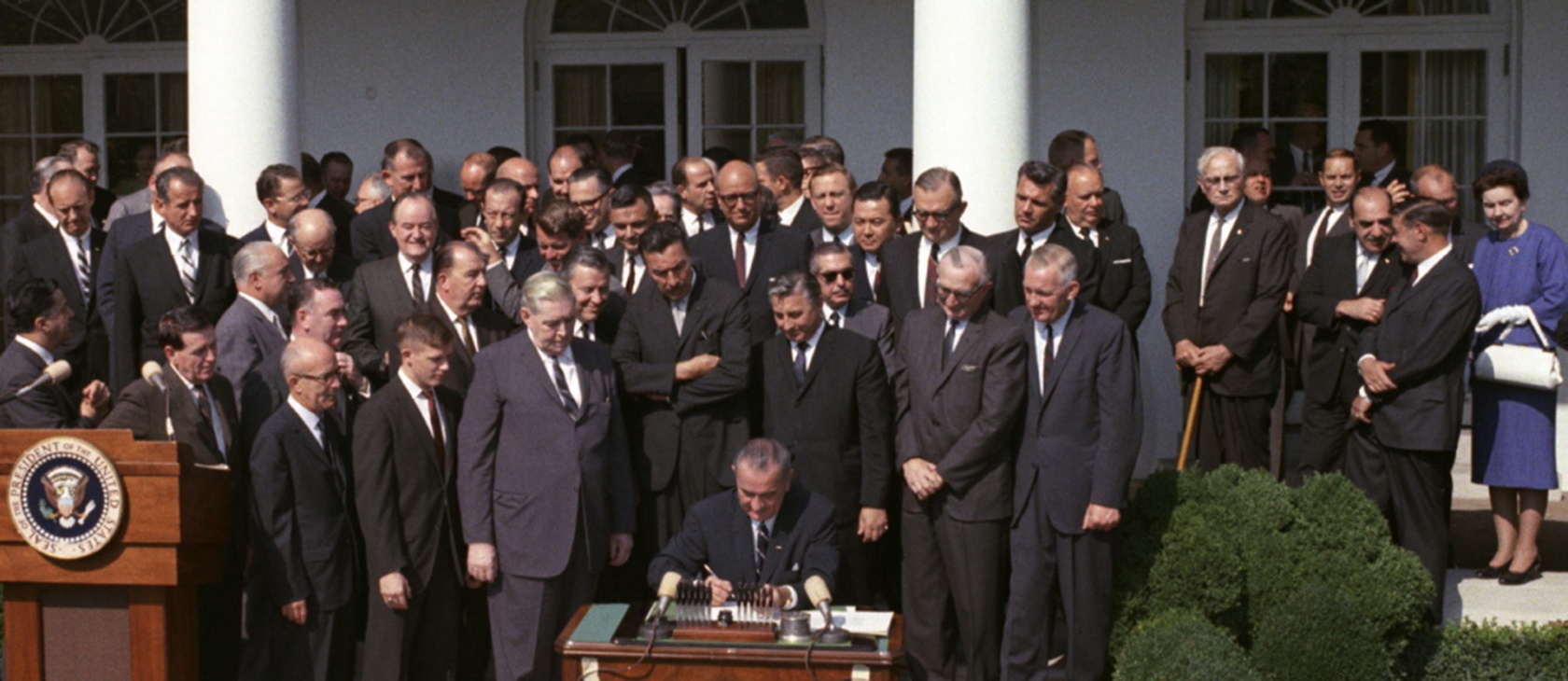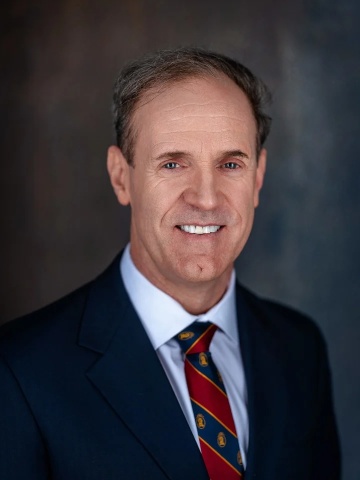Perhaps it is because America is the land of liberty and opportunity that debates about poverty are especially intense in the United States. Americans and would-be Americans have long been told that if they work hard enough and persevere they can achieve their dreams. For many people, the mere existence of poverty—absolute or relative—raises doubts about that promise and the American experiment more generally.
Is it true that America suffers more poverty than any other advanced democracy in the world? And that higher minimum wages and bigger labor unions are key solutions? You’d think so after reading a popular sociologist. But the numbers tell a different story.

Matthew Desmond
(Crown Publishing Group, 2023)
To the best of my knowledge, no other country has embarked on a “War on Poverty,” to use the unofficial title given to the legislation foreshadowed by President Lyndon B. Johnson in his 1964 State of the Union address. In Johnson’s words, “Our aim is not only to relieve the symptom of poverty, but to cure it and, above all, to prevent it.”
In retrospect, these sentiments appear rather naive. For one thing, they make no distinction between absolute poverty and relative poverty. In all societies, some people are always relatively poorer than others, but that does not necessarily mean that they are starving or destitute. Rather, it means that some people are less wealthy than others. Relative poverty in America is very different from relative poverty in Chad.
If there is anything we have learned over the past 62 years since President Johnson declared war on poverty, it is that the law of unintended consequences applies just as much to poverty-relief programs as it does to everything else. Over the past half century, government spending on welfare has increased by 600%. That has helped facilitate the growth of welfare bureaucracies at the federal, state, and even local levels with a vested interest in their own institutional preservation.
Despite these problems, there remains a tremendous political desire primarily on the part of American progressives to use state power to try and purge poverty from the American body politic. The latest expression of this aspiration is a book by the Princeton sociologist Matthew Desmond, Poverty, by America. Despite all the government programs put in place since the 1960s, Desmond maintains that approximately 30 million Americans live in poverty, with another 30 million living on the edge of poverty or what’s called “near-poverty.” Taken together, that would be just over 18% of Americans.
It’s not unusual for progressives to invoke big, dramatic numbers when discussing poverty. The point of the exercise is, after all, to create a sense of urgency and the subsequent need for government to act dramatically. In Desmond’s case, the desired urgency is further underscored by his invocation of particular stories designed to put a human face on the poverty that, he argues, afflicts almost 20% of the American population.
Such stories, though distressing to read, form part of an overall narrative that relies at particular points on sheer emotivism. That same narrative, however, is also unsustained by important facts.
Let’s begin with Desmond’s core claims about extreme poverty. According to Desmond, America is characterized by “a kind of extreme poverty” of the “bare feet and swollen bellies” variety. This claim flies in the face of extensive evidence that the real poverty upon which his book focuses attention has—far from growing—been radically diminished.
Take, for instance, a recently released 2023 Journal of Political Economy study. Employing what the authors call “an absolute Full-income Poverty Measure (FPM),” which “uses a fuller income measure” rather than the official poverty rate, “and updates thresholds only for inflation,” this paper showed that since the beginning of President Johnson’s War on Poverty, the “absolute FPM rate fell from 19.5 to 1.6 percent.”
According to Desmond, America is characterized by ‘a kind of extreme poverty’ of the ‘bare feet and swollen bellies’ variety.
That is an amazing achievement. It indicates that, statistically speaking, the war against serious poverty has effectively been won. Moreover, when we add to this mix the fact that the poor in America generally have cellphones, air conditioning, cars, are not even close to starving, etc., we see that, in terms of consumption patterns, the realities about poverty in America simply do not match Desmond’s very bleak portrayal.
In fairness, it should be pointed out that the authors of the JPE study note that, unfortunately, “relative poverty reductions have been modest.” That is certainly something to be concerned about. But they also stress another trend: that “government dependence increased over this time, with the share of working-age adults receiving under half their income from market sources more than doubling.” The economic and social implications of this unfolding development, which appear to be disproportionately affecting working-age males, are just as much a cause for worry.
What’s curious about this particular trend is that the FPM fell in the 1990s along with a fall in welfare dependency among black children, black working-age adults, and working-age adults in general. That period correlates to the welfare reforms passed by a Republican Congress and a Democratic president in the middle of the decade. This suggests, as the JPEauthors observe, that “a rise in dependence is not a necessary condition for a reduction in poverty.” That is very good news insofar as it indicates, at a minimum, that you can reduce poverty and diminish welfare dependency at the same time. Poverty alleviation, in other words, need not facilitate soft despotism.
One can also question Desmond’s claims about poverty in America compared to other wealthy nations. America, Desmond states, is “the richest country in earth, with more poverty than any other advanced democracy.” Again, the numbers don’t indicate this.
In 2019, for instance, the National Academy of Sciences published A Roadmap to Reducing Child Poverty. Among other things, it included an analysis of child poverty rates across major Anglophone countries. According to its absolute measure of deprivation, the child poverty rate in Canada (10.3) and Ireland (11.3) is only slightly lower than that of the United States (12.5), while Britain’s (13.5) is slightly higher than America’s. The Anglophone country that does the best in this category is Australia (8.1).
Desmond might counter that the measurement he is using identifies the poverty level at half of the median income of the advanced democracies. But it is precisely because America has some of the highest median incomes in the world that relative poverty measurements make it seem poorer. That’s why an absolute measure of deprivation is a far more meaningful point of comparison between American and other advanced economies.
Putting aside the questionable statistical foundations for his claims, another dimension of Desmond’s argument merits considerable scrutiny. This concerns his contention that the wealthy actually benefit from the poverty endured by their fellow Americans. Put another way, the poor are poor because not-poor Americans and policymakers will it to be so. That is quite an assertion, but it turns out to be as doubtful as Desmond’s use of poverty measurements.

An example of this concerns the minimum wage. “Corporate profits rise,” Desmond says, “when labor costs fall.” According to Desmond, it benefits American businesses to keep the minimum wage as low as possible because it boosts their profits. That, he believes, translates into effectively locking particular categories of people into subsistence wages. It follows that the minimum wage must be raised.
Increasing minimum wage rates, however, will not likely pull significant numbers of Americans out of poverty. Moreover, Desmond himself acknowledges that going down that path will probably cost jobs. Many employers will respond to minimum wage increases by reducing their number of employees either by consolidating positions or turning to automation to replace people. Minimum wage increases also tend to price entire categories of people out of, say, entry level jobs. (Think unskilled workers, young people less interested in an income than they are in acquiring basic work skills, etc.) In any case, Desmond doesn’t account for the fact that, in developed nations like the United States, a higher degree of average labor productivity generally translates into higher average wages, and minimum wages have little to do with productivity.
A similar observation may be made about Desmond’s belief that America needs bigger and stronger trade unions (a claim, incidentally, also being made by interventionists on the conservative side of American politics today). That, Desmond believes, is one way to reverse what he believes to be the anemic growth in wages that helps account for considerable poverty in the United States.
That claim, too, runs into a basic objection: wages and incomes for average workers have not been more or less stuck for 30 years. As the economist Michael R. Strain observes in a Project Syndicate article entitled “The Myth of Income Stagnation”:
According to the CBO, median household income from market activities—labor, business, and capital income, as well as retirement income from past services—was not stagnant from 1990 to 2019. Instead, after adjusting for inflation, it grew by 26%. This is in line with wage growth. By my calculations using Bureau of Labor Statistics (BLS) data, inflation-adjusted average wages for nonsupervisory workers grew by around one-third over this period.
Moreover, a more comprehensive measure of the flow of financial resources available to households for consumption and savings helps to account for the non-market income they received and for the taxes they paid. After factoring in social insurance benefits (from Social Security and unemployment insurance, for example), government safety-net benefits (such as food stamps), and federal taxes, the CBO finds that median household income increased by 55% from 1990 to 2019, which is significantly faster than wage growth and certainly not stagnate. The bottom 20% of households enjoyed even greater gains, with market income growth of 51% and after-tax-and-transfer income growth of 74%.
None of this is to suggest that everything stated by Desmond in this book is wrong. In fact, there are some important points that he makes that should be highlighted. Desmond notes, for example, that a good deal of welfare spending goes to people who are not its intended recipients. That includes lawyers who make money out of suing the government, as well as middle-class families with bright accountants skilled at extracting considerable amounts of largesse from the government.
Increasing minimum wage rates will not likely pull significant numbers of Americans out of poverty.
Another instance where Desmond is correct concerns his attention to the ways in which regulations and ordinances severely limit opportunities for housing construction in many parts of the country. The effect is to put home ownership—and the many positive cultural, social, and economic effects of owning property—out of reach of a considerable number of Americans. This also makes it difficult and more expensive for people to leave their suburbs, towns, or even states to pursue work opportunities. Those who consequently find themselves least able to make such major changes in their lives are those on the lower end of the income scale. The solution is to reduce the scope of regulations applying to housing construction: in other words, to liberalize some of the conditions surrounding the housing market. It is not clear to me, however, that Desmond would be willing to accept this.
In the end, curiously enough, Desmond’s primary preferred approach for addressing poverty is less about policies than it is about changes in attitude. Economically well-off Americans, he argues, need to take off their blinders about those in need around them and alter their choices and actions accordingly.
That means rethinking things ranging from where we shop and how we invest our capital to whom we employ and where we choose to live. “We must ask ourselves,” Desmond writes, “and then ask our community organizations, our employers, our places of worship, our schools, our political parties, our courts, our towns, our families: What are we doing to divest from poverty?” It is more than a whole-of-government approach to poverty that Desmond is calling for; he wants a whole-of-society approach to “finally put an end to it.”
The difficulty with all this is that America has already put an end to the type of poverty that certainly should seriously bother Americans. But the broader problem with his concluding recommendation is that the key to poverty reduction is long-term economic growth. And economic growth is delivered when people are allowed to pursue their self-interest peacefully in a context of rule of law, constitutionally limited government, private property rights, and dynamic entrepreneurship.
The fact that these conditions have been the exception rather than the norm for most of human history is why poverty was, until relatively recently, the everyday economic reality experienced by most humans. Understanding this and then acting accordingly is the attitudinal and behavioral shift that will give us an America that lives up to its promise.













